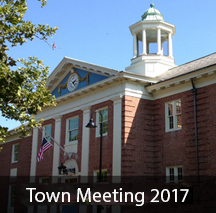 (Editor’s note: Additional stories about the March 25 Annual Town Meeting will be published this week.)
(Editor’s note: Additional stories about the March 25 Annual Town Meeting will be published this week.)
Lincoln will move ahead with feasibility studies for both a locally funded school project and a community center as a result of votes at Saturday’s Annual Town Meeting.
Residents voted unanimously to release $750,000 that was put aside in 2015 for a new feasibility study that will lead to another town-wide vote a year from now on a specific project to pursue. The money was originally allocated for a project that specifically would have included state funding; in the wake of repeated denials from the Massachusetts School Building Authority, Saturday’s vote means the money can now be used for a project funded solely by the town.
As a result of the vote, residents passed over another warrant article that asked whether Lincoln should apply once again for MSBA funding. School officials have said that the chances of Lincoln getting invited into the funding pipeline again were extremely slim because the Lincoln School is not structurally unsafe or severely overcrowded.
“There seems to be a growing sense of community readiness to move forward,” School Committee Chair Jennifer Glass said. “This will also provide clarity for other decisions in town” such as the community center.
Glass and Finance Committee Chair Peyton Marshall reviewed information they presented at multi-board meetings on January 30 and March 8 about why a major school project is needed, how much it might cost, and the tax implications of various levels of borrowing to pay for it. Consultants Dore and Whittier said in 2014 that basic repairs and required code upgrades for safety and handicapped accessibility will cost at least $30 million.
“That’s a lot of money, but there really is no ‘do nothing’ option,” Glass said; that level of spending would result in a building that’s “safe, accessible, has better air and light, no leaks and comfortable temperatures” but has no other improvements. Depending on what additional options are chosen such as educational upgrades, cafeterias and site work pr even an entirely new school, the project could cost up to $68 million.
“The point of the feasibility study is to narrow [cost estimates] down to some number that we bring to the town, and the town votes on which one of these project concepts to we develop into a real project” at a vote in spring 2018. After that, detailed plans and costs will be finalized and the project will come up for a bonding vote perhaps as soon as Fall 2018, Glass said.
Asked by a resident whether the town could simply reuse the 2012 feasibility study, Glass said, “I recommend not doing that.” That study resulted in a plan that failed to win a two-thirds bonding majority in 2012 for various reasons, including cost and the layout of the new school building and campus. This time around, residents will have a chance to choose form one of two or three design concepts before the funding is put to a vote.
The silver lining of the 2012 defeat is that “we’ve learned some things since then—how to be even more creative with spaces in the building and a sense of how the campus maintains a feeling that everyone is happy with,” Glass said.
Community center vote
With only a handful of “nay” votes, residents also voted to spend $150,000 for a feasibility study for a community center to house the Council on Aging and the Parks and Recreation Department as well as other town groups. A 2015 report by the Community Center Study Committee and its consultant said that a two-story, 22,000-square-foot facility on the Hartwell side of the school campus would cost about $13 million.
The $150,000 appropriation must also win a simple majority at the March 27 town election to move forward.
The feasibility study would result in a conceptual site plan and an updated cost estimate, but there is no timeline for when construction might start. However, the school and community center building committees and architects would work closely together to coordinate planning for the two projects as much as possible. This collaboration would ensure that a community center “can be added to the campus at the right time and in the right location and configuration,” and its construction would “follow at a time that is fiscally responsible,” Selectman James Craig said.
Asked if the two building committees would join to hire a single architect, “the answer is a big maybe,” Glass said. Such a firm would need to have expertise in both types of projects “and they’d have to be a good fit for our endearing and occasionally idiosyncratic town. “If two different firms are used, town and school officials can make collaboration between those firms “a foundational requirement for getting hired,” she said.
Several residents recommended combining the feasibility studies as well as using a single architectural firm. Staff members at a school and community center provide many of the same teaching and counseling functions, said Doug Swain. “Their educational and quality-of-life goals for people in the town of Lincoln are exactly the same and their building needs are almost identical.”
A completely shared space isn’t possible because of state regulations designed to limit access to school children by non-school staff.
Resident Ken Hurd, an architect, said he supports both projects but was not in favor of developing separate schematic drawings for the school and community center. In talking to other architects and engineers, “most of them think this is a bad idea to have two teams working in parallel in trying to master-plan a [campus] site,” he said.
“We really need to hire one architect with two teams in its firm, as well as a good land architect. This is a site and campus planning exercise as well,” said resident Owen Beenhouwer, also an architect. Any firm that’s qualified to design a school “will have more than ample experience in dealing with a smaller building as well.”
“Nothing is off the table in terms of the firm” to be hired, Craig said. “The goal is to have these [projects] be in concert with each other.”
Moving forward, planning for the community center will include refining the exact needs of the COA and PRD in terms of their programming and space usage, as well as considering future uses for Bemis Hall.
Cost implications
Right now, Lincoln is in a good borrowing position compared to other area towns in terms of property tax rate growth and its debt-to-operating-budget, Marshall said. The town could borrow up to $80 million to pay for school and community center projects without endangering its AAA bond rating, he said.
Assuming a 30-year bond at an interest rate of 5 percent and the current median property value of $972,200, the maximum annual average tax increase during the repayment period would range from $929 (for a $30 million bond) to $2,478 ($80 million). The median taxpayer would see a hike of $275-$310 per year for every $10 million the town borrowed, according to page 11 of his handout. The median property tax bill in fiscal 2018 is $13,613.


